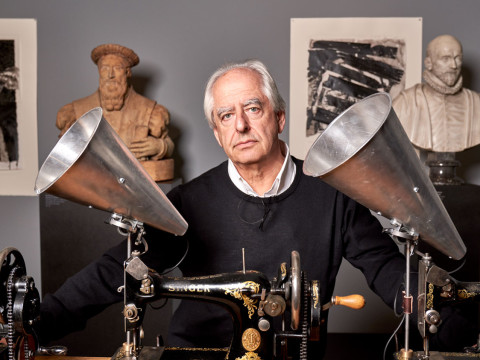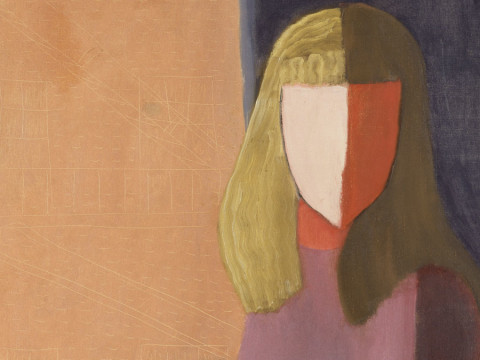
A beginner's guide to Félix Vallotton
By Anna Testar
Published on 21 May 2019
From bohemian Paris to the battlefields of the First World War, Félix Vallotton’s art was shaped by a tumultuous epoch – but his vision remained distinctly his own.
He was Swiss-born, but made his name in Paris
“The very singular Vallotton” is how Thadée Natanson, co-founder and editor of the cultural journal La Revue blanche, described his inscrutable friend. Born in the Swiss city of Lausanne in 1865 and raised in a modest, Protestant household, Vallotton moved to Paris as a 16-year-old aspiring artist, situating himself at the heart of the contemporary art world. He remained in France for the rest of his life, becoming a citizen in 1900. But despite living through one of the most profound periods of change in the history of Western art, Vallotton would ultimately remain loyal to traditional modes of depiction, favouring the representation of reality over the artistic experimentation which led to avant-garde movements such as Impressionism and, later, Cubism and Abstraction.
In the 1890s, he rose to fame for his witty illustrations mocking the lives of the bourgeoisie and satirising chaotic daily life in the city. He became associated with a group of artists known as the "Nabis", forming close friendships with its key members, Pierre Bonnard and Edouard Vuillard, and for a time adopting their aesthetic. But his marriage in 1898 to the wealthy widow Gabrielle Rodrigues-Henriques, sister of the owners of the famous Bernheim-Jeune Gallery, placed him firmly within the social class he had previously derided. Assured of a financially secure future thanks to his new wife, Vallotton no longer had any need for the income provided by his illustrations. He promptly abandoned the style which had brought him success and recognition and devoted himself to painting, developing the hard-edged, disquieting style which defines the many nudes, still-lifes and landscapes he produced in the final 25 years of his life. His friend was right: Vallotton was a truly singular artist.

He was a virtuoso printmaker
“This newcomer, who is not a beginner, engraved on blocks of soft pearwood various scenes of contemporary life with the candour of a sixteenth-century woodcut.” So remarked the critic, Octave Uzanne, about Vallotton’s exceptional talent for printmaking. The artist played a central role in reviving the European woodcut tradition, which had subsided after its popularity in the Northern Renaissance among artists such as Albrecht Dürer. Vallotton took up the medium in 1891, and quickly found success as one of its most accomplished and sought-after practitioners of the day.
With sharp wit and technical virtuosity, he harnessed the dramatic contrast of black ink on white paper (undoubtedly taking inspiration from the shadow plays he had seen performed at the Cabaret du chat noir) to compose radically simplified scenes of public and private life in Paris. In caustically disdainful vignettes mocking the bourgeoisie, men and women live hedonistic, hypocritical lives of infidelity and dishonesty. Elsewhere, protesters scramble through anarchist uprisings, pedestrians rush for cover from downpours and shoppers search for the latest luxury goods.
Technological developments in the printing press and a lively scene of political and cultural debate had led to a vast increase in the publication of illustrated journals and newspapers. With his biting observation and unique aesthetic, Vallotton became a sought-after contributor to these. He was invited to become the principal illustrator of the highly influential journal La Revue blanche, a position which propelled him into the limelight and drew him to the attention of artists such as Henri de Toulouse-Lautrec. Despite his immense skill, Vallotton all but abandoned printmaking in 1900, only returning to it in 1916 to produce a portfolio on the subject of the First World War.

He (briefly) joined the stylistic revolution of Bonnard and Vuillard
Vallotton stayed true to his artistic independence during his first decade in Paris. Despite graduating from the progressive Académie Julian in 1885, he remained stylistically loyal to his classical heroes, particularly Ingres and Holbein, and maintained a distance from the avant-garde. But his work underwent a drastic change in the early 1890s when he met a group of artists called the "Nabis", or "Prophets". Their best-known members were Edouard Vuillard, Pierre Bonnard and Maurice Denis, and they took inspiration from the decorative Post-Impressionist style of Paul Gauguin, which placed art’s potential to convey emotion above its function as a record of the external world. Another key influence on these artists was the Japanese woodblock prints which were so popular in Paris at the time.
The group became aware of Vallotton thanks to his association with La Revue blanche, to which they were also frequent contributors, and within a year of the newfound friendship his painting style metamorphosed from formal portraits and still-lifes into decorative, evocative scenes of everyday life. Viewed from unusual perspectives, women bathed in idealised landscapes and figures moved silently along Parisian streets, their forms described by flat blocks of colour in an aesthetic which also emerged in Vallotton's prints. But, ever the individual, Vallotton never fully immersed himself in the group. Along with his Swiss nationality, this degree of distance earned him the nickname "the foreign Nabi". In 1900, the members went their separate ways, and Vallotton swiftly returned to his own path, abandoning their style completely.

Moonlight (Clair de lune), 1895

Bathing on a Summer Evening (Le Bain au soir d’été) , 1892-93

The Visit (La Visite), 1899
He was more than just a painter and printmaker…
In fact, the artist also wrote three novels and eight plays, designed stage sets, took photographs and made sculpture. In his best-known novel, La vie meutrière (The Murderous Life), the protagonist, Jacques Verdier, is possessed of a power which causes everyone in his path to die in a tragic accident. Vallotton illustrated the novel himself in the darkly humorous style also found in standalone prints such as The Murder. Vallotton’s friend Vuillard co-founded a theatre company called the Théâtre de l’Œuvre in 1893, for which the Nabi group produced designs for sets and programmes. Vallotton was later inspired to try his own hand as a playwright, and in 1904 his play Un Homme très fort (A Very Strong Man) was performed at the Théâtre de Grand Guignol in Paris. In 1899, Vallotton acquired a Kodak camera and began to take snapshots of his surroundings: summer holidays, domestic scenes and visits to friends. He began to use these aides-mémoires for his paintings, working from them in the studio and manipulating the compositions, creating strange, fictionalised versions of reality. He also experimented with sculpture for a brief period, producing a small number of bronze nudes in 1904.
He depicted the trauma of war
“‘War! The word is magnificent...” This was Vallotton’s emotive and deeply patriotic reaction to the outbreak of World War One, as he recalled in 1917. The artist was desperate to contribute to the war effort on behalf of his adopted country and dismayed that, at 49 years old, he was too old to enlist. Instead, he drew upon his metier as an artist and produced a series of images in response to the fighting. Briefly reviving his long-abandoned talent for printmaking, he produced a portfolio of woodcuts called C’est la guerre! (This is War!), comprising six illustrations of wartime scenes taken from newspaper images. Despite the gravity of its subject-matter, the series nonetheless displayed the decorative style and dry wit of Vallotton’s early woodcuts. In 1917, he was finally able to encounter the war at first hand, and undertook a government commission to spend two weeks in the Champagne region recording the effects of the war, painting ruined churches and bombed houses, and a scene of the battle at Verdun.

His cinematic style still resonates today
Vallotton’s name is largely absent from the art historical canon of the late nineteenth and early twentieth centuries, yet his legacy may be greater than his reputation suggests. A master of narrative suspense, his series of interior scenes from 1897–99 offers a voyeuristic lens onto private worlds of forbidden love and heartbreak – ambiguous scenarios which find echoes in the work of Edward Hopper. That cinematic quality, which was undoubtedly influenced by Vallotton’s interest in theatre, could even have found its way into the films of Alfred Hitchcock, while his unique colour palette is comparable to the film sets of Wes Anderson. Perhaps traces of the "very singular Vallotton" can be found in the development of twentieth-century art and culture after all.
Anna Testar is the Assistant Curator of Félix Vallotton: Painter of Disquiet.

Félix Vallotton: Painter of Disquiet
This is the first comprehensive survey of Félix Vallotton’s career to be held in the UK.
Through more than 80 paintings and prints, we explore an extraordinary body of work: from compelling portraits, magnetic still-lifes, luminescent landscapes and bitingly satirical prints, to interior scenes which reverberate with psychological tension.
Related articles

A beginner's guide to William Kentridge
19 July 2022

A beginner's guide to Milton Avery
12 July 2022

13 things to know about Francis Bacon
14 February 2022

Light Lines Tour with Hélène Binet
23 November 2021

A beginner's guide to Michael Armitage
21 May 2021
